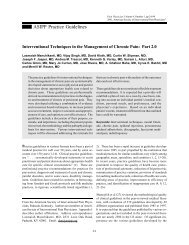Practice Management - Pain Physician
Practice Management - Pain Physician
Practice Management - Pain Physician
You also want an ePaper? Increase the reach of your titles
YUMPU automatically turns print PDFs into web optimized ePapers that Google loves.
Manchikanti • Documentation, Billing and coding 221<br />
medical program of the uniformed services for treatment<br />
provided to patients in general practice (2). In some recent<br />
high-profile cases, Fresenius Medical Care, Lexington,<br />
Massachusetts, agreed to pay the government $486<br />
million to settle fraudulent billing and kickback charges<br />
against a company acquired in 1996. Similarly, Beverly<br />
Enterprises, Inc., of Fort Smith, Arkansas, also agreed to<br />
pay the US Government $170 million in restitution plus a<br />
$5 million fine to settle civilian criminal allegations of a<br />
nationwide scheme to defraud Medicare from 1992 to<br />
1998. Consequently, whistle blowers in Fresenius settlements<br />
will take home a staggering $65.8 million from the<br />
civil recovery settlement. An anesthesia group settled for<br />
$3.2 million for insufficient supervision, and an emergency<br />
physician group settled for $15 million for upcoding. This<br />
is not surprising considering that Qui Tam lawsuits increased<br />
74% in 1997. Table 3 shows Qui Tam cases and<br />
recoveries. In 1999 work plan, the OIG is targeting<br />
600,000+ physicians in practice.<br />
DOCUMENTATION OF MEDICAL<br />
NECESSITY<br />
Medical necessity requires appropriate ICD-9-CM diagnosis<br />
codes with their distinct rules for Volumes I and II to<br />
justify services rendered and indicate the severity of the<br />
patient’s condition (3). The Balanced Budget Act (HR<br />
2015, Section 4317) requires all physicians to provide the<br />
diagnostic information for all Medicare/Medicaid patients<br />
starting from January 1, 1998, failure of which can result<br />
in prosecution (4). The International Classification of<br />
Diseases, also known as ICD-9-CM, is a system used to<br />
document complaints, symptoms, conditions, problems,<br />
and diagnosis for an encounter or procedure. <strong>Physician</strong>s<br />
should code by listing the ICD-9-CM diagnostic codes<br />
shown in the medical record to be chiefly responsible for<br />
the services provided. Coding should be to the highest<br />
degree of certainty for each encounter and each interventional<br />
pain procedure. Coding also should correlate with<br />
multiple components the of patient’s medical record including<br />
initial evaluation or history and physical, operative<br />
report or procedure note, and also the billing statement.<br />
However, chronic conditions treated on an ongoing<br />
basis, such as in an interventional pain management<br />
setting, may be reported as many times as the patient receives<br />
treatment and care for the condition. If proper diagnosis<br />
is not established, codes that describe symptoms<br />
and signs, as opposed to the diagnosis, are acceptable for<br />
reporting purposes until the diagnosis is confirmed.<br />
There is significant confusion with regards to what constitutes<br />
appropriate documentation and provides medical<br />
necessity in interventional pain management. The arena<br />
of medical record documentation is similar to evaluation<br />
and management services though there are some differences.<br />
History and physical during the first visit is the<br />
same as described for evaluation and management services<br />
in pain management (4). Once the initial evaluation is<br />
performed, a history and physical may be developed in a<br />
simpler format showing the pertinent facts and important<br />
issues as required by law, as well as either policies of practice<br />
or institutional policies such as surgery centers and<br />
hospitals. History and physical has to be updated each 30<br />
days for repeat visits and repeat interventional pain pro-<br />
T able 3. Qui Tam Cases and Recoveries<br />
FY<br />
FY<br />
FY<br />
1996<br />
1997<br />
1998<br />
Qui<br />
Tam cases filed<br />
346<br />
546<br />
469<br />
Qui<br />
Tam cased filed alleging health care fraud<br />
176<br />
306<br />
273<br />
Health-care fraud<br />
claims (millions)<br />
judgments/settlements in matters with Qui Tam<br />
$ 66<br />
$ 608<br />
$261<br />
Total<br />
health-care fraud judgments/settlements (millions) $ 136<br />
$ 961<br />
$300<br />
Source: Department of Justice<br />
<strong>Pain</strong> <strong>Physician</strong> Vol. 3, No. 2, 2000
















